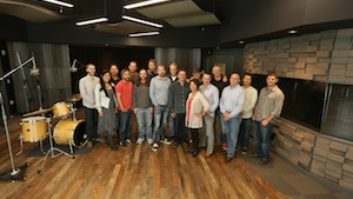Joel Stoner (left) with the staff of Burbank-based AlterMedia. When I was in college back in the 1980s, one of my studio production teachers told the class to go to the office store and buy a Rolodex and fill it up. It was an actual graded assignment that seemed novel at the time, but it taught the importance of keeping track of your contact info in a business where “who you know” makes all the difference. I added another dimension to the standard alphabetization by marking the top edge of each card in designated columns for ‘studio,’ ‘producer,’ ‘engineer.’ ‘musician;’ making it easy to find what I was looking for. I thought it was pretty clever, and so did my teacher. That assignment planted a seed that has grown into a pretty big tree.

After college, I got a job at a growing studio in LA that initially had one room, but then grew to four, then seven. These were all scheduled in a giant custom-made book, a page for each day, and full of scribbles and eraser marks.
As I headed out into the world as an independent engineer, I saw other studios used custom-stenciled whiteboards to go along with their big books. I always wondered how they’d look back at their history since it was eventually reduced to a smear of dry erase dust. But I was there to engineer, not run their business.
I needed to make invoices for the jobs I was doing. I designed a decent-enough invoice in Word and had it made into carbonless copy paper so I could give a copy and keep copy. I got tired of writing the same info at the top for my repeat customers right around the time I got my first computer. With a copy of FileMaker Pro, I made a basic invoicing database that connected to a contacts database.
My mind exploded as I came to the realization that there needed to be a universal solution for this problem every studio and engineer faced. I started working day and night, obsessively, on a collection of studio-oriented databases. I would literally dream about the connections between contacts and phone calls, projects and all the items inside it, and how they referred to specific rooms, equipment, media, people, or services, tapes, track sheets (remember?). All of these had their own properties, and of course, rates, all of which would flow out to the invoices I originally started with. Features, buttons, fields, screens, print outs…. It seemed that everything in the studio universe was connected in 3D space much like the cells of our brains, or like the blocks of a Rubik’s Cube, with each facet spinning around in relation to the others in infinite combinations, yet all connected.
Then came the era of the ADAT, with Pro Tools sneaking up behind. The democratization of studios was at hand—everyone was building studios, and the need for the product of my obsession was growing right alongside the pace of change. That change not only multiplied the number of studios, but also increased the places they were found—specifically, most large corporations, universities, city, state and federal government entities, militaries—they all started building audio and video production studios. These ‘new breed’ studio owners were more interested in the ‘business’ part than the ‘studio’ part, and needed something better than dry-erase smudges and big books filled with eraser dribbles. They needed statistics— usage reports, budgets versus actuals, profit versus loss, monthly/weekly statements, hooks to other accounting software.
The changes kept coming. Digital media asset management. Metadata. The need to link and launch files, deliver them electronically, tie the calendar into the larger corporate calendar or sync with Google Calendar. Notifications. Export the invoices or summary reports to third-party accounting software, handle large-volume equipment rental workflows, high-end film budgeting—the needs list went on and on.
Accessibility: “I’ll check the book when I get to the studio” has been replaced by clients wanting/being able to request time from a website, to the managers being able to get those requests on their phone and accepting them as projects that get created back at the studio. Studios with multiple locations can now all be on the same web-accessible ‘private cloud’ database at the same time. For staff, a computer or phone—and maybe soon a watch—have now replaced that old punch clock.
Creativity: One thing about creative people is they’re so damn creative. Everybody wants their stuff to look and feel and even operate in a way that matches their particular version of cool, or even just their particular creative workflow. Cloud-based project management applications have some great advantages for formulaic, rigid processes like accounting and shopping carts and Facebook, but today’s ‘bleeding-edge’ creative studios are using locally installed software that lets them all have unique interfaces and functions that meet their ever-evolving needs, and helps them grow toward tomorrow’s opportunities, no matter where they are.
AlterMedia
studiosuite.com
Joel Stoner is the creator of Studio Suite studio management software, and the Founder/CEO of AlterMedia, Inc, a company the focuses on the unique business management workflow needs of media production facilities.


